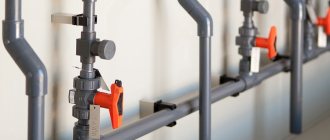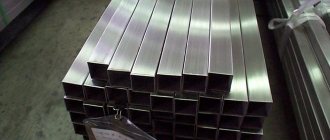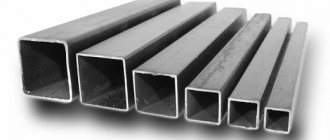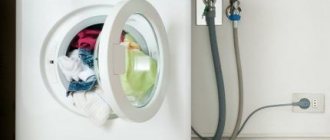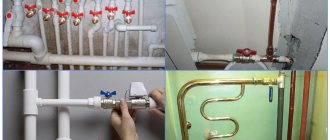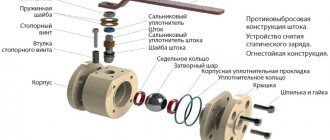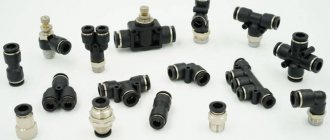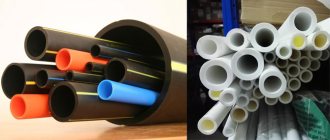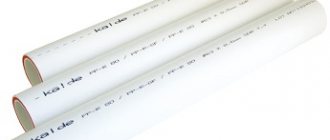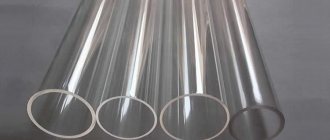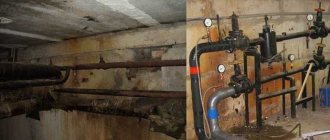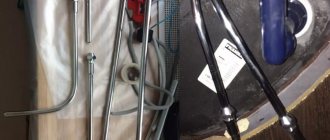Pipelines made from polypropylene pipes are widely popular due to their high cost, durability of use and ease of installation. When constructing such pipelines, as a rule, similar fittings are used, that is, a propylene tap and other fittings. Read on to learn how to choose and install a polypropylene faucet correctly.
Accessories for plastic pipelines
Polypropylene tap and its main characteristics
Propylene ball valves are used to solve the same problems as their metal counterparts. But products made from this polymer compare favorably with those due to their light weight and ease of attachment. Due to this, the installation speed of polypropylene systems is significantly higher than that of metal ones. In addition, valves made of polypropylene provide low hydraulic losses; by the way, they do not require additional maintenance.
The mechanism of action of a polypropylene valve is absolutely identical to the operation of a brass ball shut-off device. To close the movement of the working medium, a ball-shaped valve with a hole made in the center is used. A rod with a ball attached to it around an axis reliably closes the movement of the flow.
Types of three-way valves
Design features suggest dividing three-way mixers into several types:
| Options | Types of three-way valves |
| Bolt mechanism type | Ball, cork (cylindrical, conical) |
| Gate bore diameter | Full bore, reduced (the diameter of the channel in the shutter mechanism is somewhat narrowed) |
| Shape of the channel in the bolt mechanism | T-shaped, L-shaped |
| Control method | Manual (lever, butterfly), with electric drive, with pneumatic drive |
| Connection method | Threaded (coupling, fitting, pin), welded, flanged |
Using the drive in combination with a remote temperature sensor, controller or manual switch allows you to automate the control process. Pneumatically driven models are safer than their electric servo-driven counterparts.
Ball valves or gate valves - which is better?
When choosing shut-off valves, the following must be considered. A polypropylene faucet can operate without interruption for several decades. According to the statements made by the manufacturers of these products, they can last up to 50 years. Cone valves differ from them in that scale is concentrated on the surface, and you can be sure that sooner or later it will become an insurmountable obstacle when closing or opening the tap. In addition, it is impossible to compare the overall dimensions of ball and cone products. And yet, cone valves require regular inspection.
Polypropylene ball valves do not suffer from such disadvantages. In addition to their low weight and high reliability, they look much nicer than other models of shut-off valves. For the production of ball valves, the following materials are used:
- steel;
- brass;
- cast iron;
- polyethylene;
Taking into account all of the above, we can draw a simple conclusion - spherical products exceed conical ones in all respects.
Differences from valves
Another common type of shut-off valves are valves, which shut off the flow using a cone-shaped shut-off element. Therefore, the question often arises, which is better: ball valves or gate valves. It must be taken into account that when using a valve, the full opening of the bore diameter is not ensured, which leads to certain hydraulic losses. In addition, scale inevitably accumulates on the surface of the cone, which over time leads to the fact that the liquid pressure is significantly reduced and the shut-off valves simply fail. Given these features, these devices require regular inspection.
Ball valves eliminate hydraulic losses and do not accumulate scale during operation. Their service life can reach 50 years, fully maintaining their performance characteristics throughout this entire period. They are also lighter in weight and more compact in size, which makes them much more convenient to use. Thus, the features of polypropylene valves and their main characteristics allow us to unequivocally state that ball valves today are the most preferred type of shut-off valves and are far superior to cone valves in all respects.
Basic parameters and design features
Each ball valve model has its own basic parameters. For example, taps made from PPRC propylene can operate in any environment. The maximum pressure for which these taps are designed is 20 MPa, and the maximum temperature can reach 95 degrees Celsius. You must understand that valves made of this material can operate at maximum pressures of up to 75 MPa.
The polypropylene faucet includes:
- a body with a handle installed in it;
- a valve in the form of a ball made of corrosion steel with a hole equal to the working diameter of the pipe on which it will be installed;
- several seals, etc.
Sectional view of ball valve
It has already been noted that the hole in the ball valve must be equal to the working diameter of the pipeline. This equality does not allow hydraulic losses during the movement of the working medium. Cranes of this class can be used on all types of polypropylene pipes, both reinforced and ordinary.
Structural properties
The main feature of the faucet is a movable ball lock made of brass. Sometimes chromium is used as anti-corrosion protection.
The ball has a through hole for liquid:
- In the open position, the hole is located in the direction of flow.
- When closed, the monolithic walls of the ball completely block the water.
To adjust the position of the ball, a tap is used that turns it 90 degrees. It has only two positions: open, closed. If you use a PP valve to adjust the flow density, there is a high probability of cavities forming in the body and failure of the mechanism.
The crane consists of the following elements:
- Polypropylene body.
- Composite body of the bolt assembly.
- Brass ball valve with through hole.
- Seal. Made of rubber or Teflon and placed outside the orifice.
- Rotary tap.
- Brass rod. To protect against corrosion, it can be chrome plated, like the shutter. For additional sealing and solidity of the structure, it is equipped with stuffing box rings, usually made of elastomer.
- Mounting screw. Provides connection between the valve and the stem.
Note! Sometimes you come across products with a ball ground at the bottom; in the resulting hole, a “sump” is formed, in which particles or scale contained in the liquid accumulate. Manufacturers use this scheme to save metal. It is not recommended to use such taps, as they are short-lived and create a lot of problems.
Which faucet is better, plastic or metal?
Cranes differ primarily in their purpose. Some of them can be used to work with cold water, others to interact with hot water. The purpose of the cranes determines their design features. Some models of cranes are collapsible, others are detachable. PP taps with a detachable design are installed where the question of disconnecting it from the network may arise. By the way, the connector can be installed on one or both sides of the valve body.
There is also a three-way ball valve
When connecting a collapsible tap, union nuts are used. They are installed in systems where fittings made of metal are used, in steel pipelines and next to heating radiators.
Collapsible propylene taps have two designs - straight and angular. If everything is clear with straight taps, then the advantage of corner taps is that they are connected to the main line directly, without the help of auxiliary couplings. This design not only facilitates installation, but also increases the maintainability of the product. Thanks to the design of the valve, it can be quickly disassembled and repaired.
IMPORTANT! There are valves that are needed to work with different media. The cavities of such products can be made of stainless steel, brass, chrome-plated, etc.
Manufacturers produce valves in different colors. Moreover, at the manufacturing stage, color markings are applied to the body, which can tell what a particular faucet is intended for. For example, a blue stripe indicates that the product is intended to be used in cold environments.
Procedure for soldering polypropylene elements
When all the necessary tools and materials have been prepared, you can proceed to the task. It is divided into two stages: preparatory and direct soldering of fittings for polypropylene pipelines. First of all, you need to prepare a place to work.
The welding machine kit includes a special clamp. It is used to secure the machine, for example, to a table. This mount is very reliable, the device will not wobble. Therefore, it will be convenient to work with him. But in some situations, soldering is performed not at the workbench, but directly next to the water supply. In such a case, the machine has a handle for holding it in weight.
Features of purchasing a polypropylene ball valve
Before purchasing a polypropylene faucet, you must carefully inspect it; there should be no damage to its surface. When rotating the rod, you need to make sure that it turns with little effort.
And yet, it makes no sense to purchase a ball valve in markets or obscure stores. Practice shows that it is indeed possible to save money there, but there are no guarantees of quality and cannot be.
A valve manufactured by a serious manufacturer is sold only through specialized retail outlets.
Features of choice
It is recommended to base your choice on the quality of the product:
- There are no cracks, chips, the surface of the product is smooth.
- Rotation of the rod must be accompanied by force. If it scrolls freely, it means the seals are bad.
- It is recommended to purchase taps from serial manufacturers. There is much less chance of getting low-quality products.
You should not purchase in the markets in order to save money. The cost of a high-quality ball valve cannot be lower than standard market prices.
Some valuable tips
When choosing a polypropylene faucet, you need to remember a few simple things:
- the thread on the valve body must match the thread on the pipe;
- purchasing a used valve can lead to leaks, with all the ensuing consequences, in the form of flooded neighbors.
- The brand is important. The fact is that many European manufacturers move their enterprises to third world countries, but do not always carry out quality control.
It is advisable to invite specialist plumbers to install the faucet. Installing shut-off valves yourself can end sadly. We must remember that the working pressure is up to 8 MPa.
Connection stage
When all the preparation is finished, you can move on to the main soldering stage. The prepared pipe is inserted into the first Teflon nozzle, and the faucet coupling into the second. The instructions indicate the heating time for polypropylene, follow the recommendations.
When the specified period has passed, the pipe and coupling should be sufficiently melted. Now comes the soldering of products. One of them is inserted into the other in full accordance with the markup. When performing a task, accuracy and speed are paramount. Under no circumstances should you twist the pipe in the coupling when they are combined, this will lead to a design defect.
This completes the welding of polypropylene pipes. All that remains is to wipe the metal elements of the device from the remains of the molten material. In this case, the soldering iron will not require cleaning for further use.
The quality of the weld can be determined visually; a small edge of molten polypropylene should form at the junction of the pipe and the locking element. In case of successful welding, the connection itself will be completely smooth, without any deformation.
The reliability of the connection of the water supply elements can be finally determined after the water has been supplied. If the task is completed in full accordance with the requirements, recommendations and instructions for the soldering installation, then the joint between the polypropylene pipe and the shut-off ball valve will be reliable and airtight. Such a connection will last a maximum period, most likely without any problems or leaks.
But it is not only the tightness of the solder that needs to be checked. It is also worth making sure that the locking mechanism is working correctly. Ball valves for polypropylene pipes should close and open completely without much effort, even when the water supply is operating.
Installation subtleties
The installation location is determined based on the fact that the crane handle should rotate smoothly. After this, you need to rewind the thread and screw it to the end of the pipe. The tap must be screwed on with some effort; this happens because the winding is pressed into the thread, preventing the formation of leaks. A similar operation is performed with the other end of the tap.
During installation, the use of KTR (gas) type wrenches is prohibited. To install these products, only plumbing tools are used.[art_yt id=”L-q8efMCeZA” wvideo=”640" hvideo=”360" position=”center” urlvideo=”https://www.youtube.com/watch?v= L-q8efMCeZA” namevideo=”Polypropylene ball valve” desc=”Types and principles of operation of polypropylene ball valves.” durationmin=”4" durationsec=”35" upld=”2012-10-11" tmburl=”https://i.ytimg.com/vi/L-q8efMCeZA/maxresdefault.jpg” thumbnailwidth=”1280" thumbnailheight=” 720"]
Currently reading
- All the ins and outs about ball valves 3 4
- What you need to know about coupling ball valves
- Walk-through taps for washing machines and more
- Important points about the ball valve for heating
Preparation of pipes, valves, fittings
The first step is to study the instructions for the soldering machine. It contains all the recommendations, as well as restrictions on the use of the machine. The instructions also contain a table from which you can determine the heating time of the pipeline elements.
Next, the workplace is prepared, as mentioned above. You need to secure the welding machine with a clamp and connect it to the network. Set the operating mode to 260 oC. The temperature is set on a special regulator.
Now you need to clean the Teflon inserts and put them on the machine. All that remains is to wait for the welding to warm up. The soldering iron must not be turned off during the entire operation. The set temperature regime will prevent overheating of the Teflon inserts. But under no circumstances should you lower the temperature. The resulting connection will be unreliable, will wear out over time and leak.
Now you can move on to preparing the pipes. First you need to make pieces of suitable sizes. All cuts should be carefully processed. The reinforcing layer is removed. Using a scissor cutter, the edge of the pipe is cut off; now you need to chamfer it with a cone-shaped cutter. The surfaces to be soldered should be degreased, cleaned of dirt, dust and uneven surfaces should be removed.
The installation of the valve for polypropylene pipes is carried out at a certain angle so that the handle is in the correct plane. To do this, you need to apply markings for welding on the pipe and coupling. Otherwise, the locking mechanism will be inconvenient to use, and sometimes completely impossible.
Service life of three way valve
The period of trouble-free operation of the device is determined by:
- Design features.
- The material from which it is made.
- Compliance of its technical characteristics with real operating conditions.
Manufacturers give a guarantee of 5-7 years for steel “tees”, but with moderate intensity they can easily last 50 years. The service life of plastic models, as a rule, does not exceed 2 years.
Rules for operating a three-way valve
The “tee” installed in the system requires periodic inspection for wear and leaks. If a leak is detected, you can try tightening the threaded connection. If the leak cannot be eliminated, the mixer will have to be disassembled. Very often it is the O-rings that wear out. Replacing them and cleaning the elements from scale extends the life of the device.
To reduce the wear of the device, it must be periodically lubricated with a special plumbing product.
Common mistakes and problems when installing a three-way valve
Errors made when installing a “tee” not only shorten its service life, but also negatively affect the operation of the entire pipeline:
- Incorrect connection of pipes increases hydraulic resistance.
- The use of models with fluoroplastic seals in systems with operating temperatures above 150 °C will require replacing the three-way mixer after 2-3 months.
- Installation in a hard-to-reach location will complicate preventive maintenance procedures.
Expert advice
- During installation, the brass body is easily damaged. To prevent this, it is better to place a thick fabric gasket under the wrench.
- To install a three-way valve on plastic pipes, special adapters are needed.
- Instead of a “tee”, you can use 2 conventional two-way valves. They must work according to a reverse pattern: when one opens, the other closes.
Frequent errors and problems during installation
The main mistake when assembling a water supply system is the uneven installation of individual plastic pipes relative to each other. The resulting distortion will spoil the strength of the finished connection and will quickly break during active use. After cutting the pipes, you need to check the cuts. They should be smooth, without protruding irregularities. Problems often arise when connecting the mixer. In this case, it is necessary to accurately calculate the pipe connections and their connections to the taps. Check the integrity of the pipeline after work.
Characteristics
This type of valve is used to shut off the flow of water moving through polypropylene pipes. These products are good because they are made of lightweight material - polypropylene, so installation takes very little time. The result is high throughput and complete absence of the need for further maintenance.
You may be interested in information: brass ball valve
The most important design feature is the movable lock
, made in the shape of a ball. When the water is blocked, this ball begins to rotate around its axis (by the way, perpendicular to the flow), thereby blocking the passage hole.
